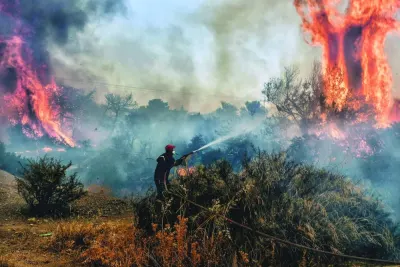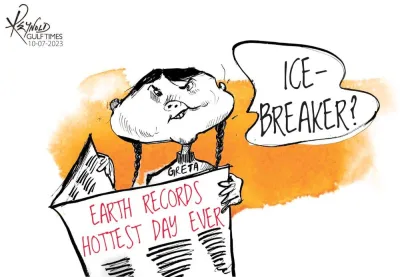Countries around the world from China to the United States are battling heatwaves, with the onset of the climate phenomenon El Nino helping push temperatures higher.Scientists told Reuters that climate change and El Nino are the major drivers of extreme heat that have seen temperature records broken in Beijing and Rome, while leaving some 80mn Americans under excessive heat warnings.El Nino is a natural phenomenon that in addition to contributing to higher temperatures in many parts of the world, also drives tropical cyclones in the Pacific and boosts rainfall and flood risk in parts of the Americas, Asia and elsewhere.In June, the US National Oceanic and Atmospheric Administration (NOAA) declared that an El Nino is now under way. The past three years have been dominated by the cooler La Nina pattern.Scientists have warned that this year looks particularly worrying. The last time a strong El Nino was in full swing, in 2016, the world saw its hottest year on record. Meteorologists expect that this El Nino, coupled with excess warming from climate change, will see the world grapple with record-high temperatures.Experts are also concerned about what is going on in the ocean. An El Nino means that waters in the Eastern Pacific are warmer than usual. Globally, sea temperatures hit new records for the months of May and June, according to the European Union’s Copernicus Climate Change Service. That could supercharge extreme weather.“We’re in unprecedented territory,” said Michelle L’Heureux, a meteorologist with NOAA’s Climate Prediction Center.This year’s El Nino could lead to global economic losses of $3tn, according to a study published last month in the journal Science, shrinking GDP as extreme weather decimates agricultural production, manufacturing, and helps spread disease. Governments in vulnerable countries are taking note. Peru has set aside $1.06bn to deal with El Nino’s impacts and climate change, while the Philippines — at risk from cyclones — has formed a special government team to handle the predicted fallout.Here is how El Nino will unfold and some of the weather we might expect:What causes an El Nino?El Nino is a natural climate pattern borne out of unusually warm waters in the eastern Pacific.It forms when the trade winds blowing east-to-west along the equatorial Pacific slow down or reverse as air pressure changes, although scientists are not entirely sure what kicks off the cycle.Because the trade winds affect the sun-warmed surface waters, a weakening causes these warm western Pacific waters to slosh back into the colder central and eastern Pacific basins.During the 2015-16 El Nino — the strongest such event on record — anchovy stocks off the coast of Peru crashed amid this warm water incursion. And nearly a third of the corals on Australia’s Great Barrier Reef died. In too-warm waters corals will expel living algae, causing them to calcify and turn white.This build-up of warm water in the eastern Pacific also transfers heat high into the atmosphere through convection, generating thunderstorms.“When El Nino moves that warm water, it moves where thunderstorms happen,” said NOAA meteorologist Tom DiLiberto. “That’s the first atmospheric domino to fall.”How does El Nino affect the world’s weather?This shift in storm activity affects the current of fast-flowing air that moves weather around the world — called the subtropical jet stream — pushing its path southward and straightening it out into a flatter stream that delivers similar weather along the same latitudes.“If you’re changing where the storm highway goes ... you’re changing what kind of weather we would expect to see,” DiLiberto said.During an El Nino, the southern United States experiences cooler and wetter weather, while parts of the US West and Canada are warmer and drier.Hurricane activity falters as the storms fail to form in the Atlantic due to changes in the wind, sparing the United States. But tropical cyclones in the Pacific get a boost, with storms often spinning toward vulnerable islands.Some parts of Central and South America experience heavy rainfall, although the Amazon rainforest tends to suffer from drier conditions.And Australia endures extreme heat, drought and bushfires.El Nino could offer a reprieve to the Horn of Africa, which recently suffered five consecutive failed rainy seasons. El Nino brings more rain to the Horn, unlike the triple-dip La Nina, which desiccated the region.Historically, both El Nino and La Nina have occurred about every two to seven years on average, with El Nino lasting 9 to 12 months. La Nina, which takes hold when waters are cooler in the Eastern Pacific, can last one to three years.Is climate change affecting El Nino?How climate change might be affecting El Nino is “a very big research question,” said DiLiberto. While climate change is doubling down on the impacts from El Nino — layering heat on top of heat, or excess rainfall on top of excess rainfall — it’s less clear if climate change is influencing the phenomenon itself.Scientists are not sure whether climate change will shift the balance between El Nino and La Nina, making one pattern more or less frequent. If ocean temperatures are rising across the board, it is unlikely the cycle would change, scientists said, as the basic mechanics behind the phenomenon stay the same.However, if some parts of the ocean are warming faster than others, that could influence how El Nino plays out by amplifying temperature differences. — ReutersExtreme heat straining health systemsThe extreme heat in the northern hemisphere is putting an increasing strain on healthcare systems, hitting those least able to cope the hardest, according to the World Health Organisation.The WHO has warned the heat often worsens pre-existing conditions, saying it was particularly concerned about those with cardiovascular diseases, diabetes and asthma.Millions of people across three continents are enduring a sustained spell of dangerous heat as temperature records tumble.“Extreme heat takes the greatest toll on those least able to manage its consequences, such as older people, infants and children, and the poor and homeless,” said WHO chief Tedros Adhanom Ghebreyesus.“It also puts increased pressure on health systems,” he told a news conference.“Exposure to excessive heat has wide-ranging impacts for health, often amplifying pre-existing conditions and resulting in premature death and disability.”The WHO was working with the World Meteorological Organisation (WMO), its fellow Geneva-based UN agency, to support countries in developing hot-weather action plans to coordinate preparedness and reduce the impacts of excessive heat on health, he added.Maria Neira, the WHO’s public health and environment chief, said the agency was particularly concerned about pregnant women and people with diabetes and cardiovascular diseases, and asthma, as air pollution would be part of the problem.Local and national governments needed to identify all those potentially at risk, while hospitals should ensure they had an action plan in place, she added.Neira also said communities needed to get the message out on avoiding sport during the hottest part of the day, finding a cool place indoors, looking out for the vulnerable, and being aware of heat stroke or heat exhaustion.Experts have blamed the heatwaves on climate change, driven by the burning of fossil fuels releasing the greenhouse gas carbon dioxide into the atmosphere.Besides immediate measures to cope with the heat in the coming days, Neira said that in the longer term, countries needed to decarbonise to mitigate the causes of climate change, which is “exacerbating and increasing the frequency, the intensity and the duration of those heatwaves.“That will be helping us to reduce the heatwaves in a very important way.”City officials needed to think through their urban planning to ensure people had refuges in times of extreme heat, she added.The UN’s WMO weather agency has said repeated high overnight temperatures are a particular health risk because the body is unable to recover from hot days, leading to more heart attacks and deaths. — AFP




















